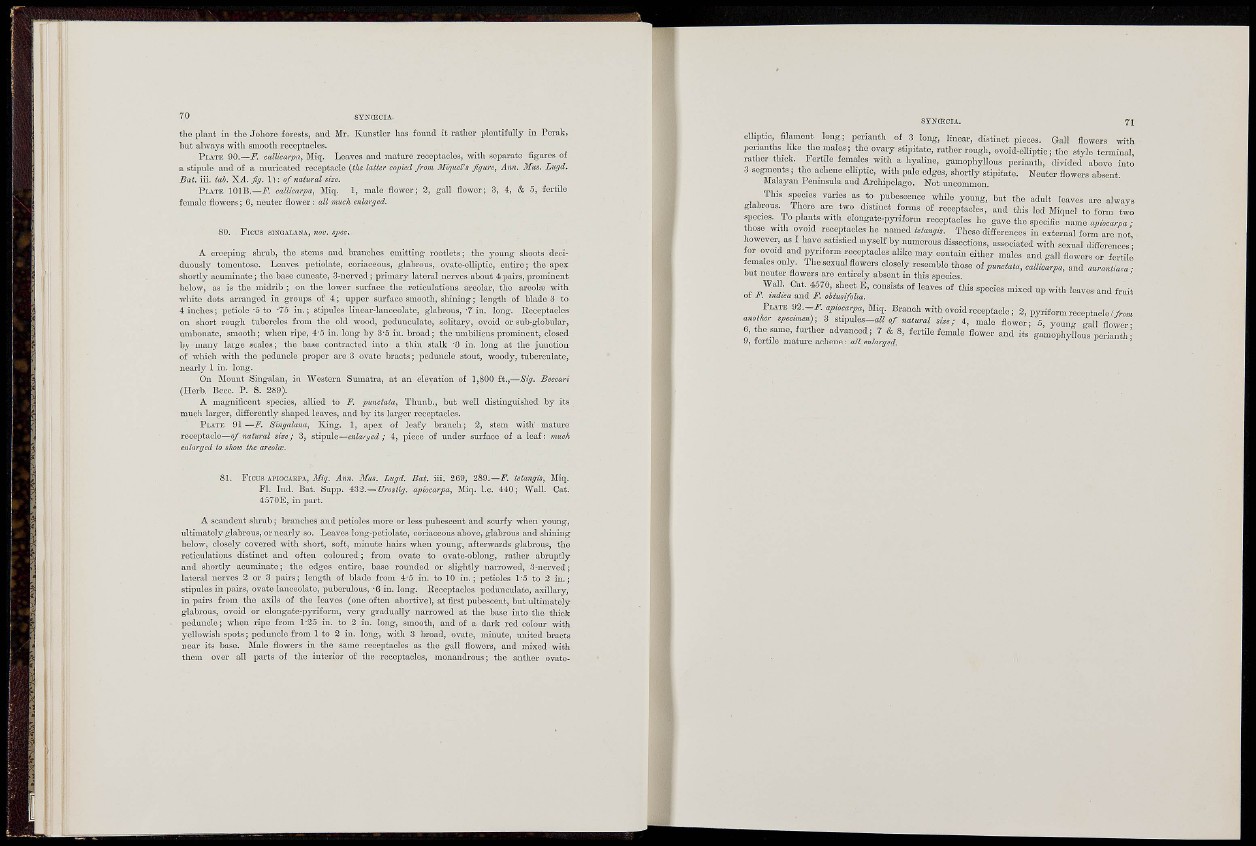
7 0 SYiiCECIA.
t h e plant in the Joliore forests, and Mr. Kunstler has fouud it rather plentifully in Perak,
but always with smooth receptacles.
PLATE 90.—F. oalUcarpa, Miq. Leaves and mature receptacles, with separate figures of
a stipule and of a murieated reeeptaclc {the latter copied from MiqueVs figure, Am. Mus. Lugd.
Bat. iii. tab. 'S.A. fig. : of natural size.
PLATE LOIB.—F. calliearpa, Miq. 1, malo flower; 3, gall flower; 3, 4, & 5, fertile
female flowers; 6, neuter flower : all much enlarged.
80. Fxcus SINGALANA, nov. spec.
A creeping shrub, the stems and branches emitting rootlets; the young shoots deciduously
tomeutose. Leaves petiolate, coriaceous, glabrous, ovate-elliptic, entire; the apex
shortly acuminate; the base cuneate, 3-nerved; primary lateral nerves about 4 paii-s, prominent
below, as is the midiib ; on the lower surface the retic\ilations areolar, the areolae with
white dots arranged in groups of 4; upper sui'face smooth, shining; length of blade 3 to
4 inches; petiole-5 to -lo in.; stipules linear-lanceolate, glabrous,-7 in. long. Rceeptacles
on short rough tubercles from the old wood, pedunculate, solitary, ovoid or sub-globular,
nmbonatc, smooth; when ripe, 4'5 in. long by 3-5 in. broad; the umbilicus prominent, closed
b y many lai-ge scales; the base contracted into a thin stalk -3 in. long at the junction
of which with the peduncle proper are 3 ovate bracts; peduncle stout, woody, tuberculate,
nearly 1 in. long.
On Mount Singalan, in Western Sumatra, at an elevation of 1,800 ft.,—Sig. Beccari
(Herb. Bccc. P. S. 289).
A magnificent species, allied to F. punctata, Thuiib., but well distinguished by its
mucli larger, differently shaped leaves, and by its larger receptacles.
PLATE 91—F . Singala7ia, King. 1, apex of leafy branch; 2, stem with' mature
receptacle—of natural sise; -3, stipule—enlaryed ; 4-, piece of under sm-face of a leaf: much
enlarged to show the arcoloi.
81. Ficus APIOCARPA, ilii'^. Ann. Mus. Lugd. Bat. iii. 269, 289.—F. tetangis, Miq.
Fl. Ind. Bat. Supp. 4=2-2.— Urostig. apiocarpa, Miq. I.e. 440; Wall. Cat.
4570E, in part.
A scandent sln.-ub ; branches and petioles more or less pubescent and scm-fy when young,
ultimately glabrous, or neai-ly so. Leaves long-petiolate, coriaceous above, glabrous and shining
below, closely covered with short, soft, minute hairs when young, afterwards glabrous, the
reticulations distinct and often coloured; from ovate to ovate-oblong, rather abruptly
and shortly acuminate; the edges entire, base rounded or slightly narrowed, 3-uerved;
lateral nerves 2 or 3 pairs; length of blade from 4-5 in. to 10 in.; petioles 1-5 to 2 in.;
stipules in paii-s, ovate lanceolate, puberulous, -Q in. long. Receptacles pedunculate, axillary,
in paii-s from the axils of the leaves (one often abortive), at first pubescent, but ultimately
glaljrous, ovoid or elongate-pyi-iform, very gradually narrowed at the base into the thick
peduncle; when ripe from 1 -25 in. to 2 in. long, smooth, and of a dark red coloui- with
yellowish spots; peduncle from 1 to 2 in. long, with 3 broad, ovate, minute, united bracts
near its base. Male flowers in the same receptacles as the gall flowers, and mixed with
t h em over all parts of the interior of the receptacles, monandi-ous; the anther ovate-
SYKCECIA. 71
elHptic, filament long; perianth of 3 long, linear, distinct pieces. Gall flowers with
perxauths like the males; the ovary stipitate, rather rough, ovoid-elliptic ; the style terminal
rather thick. Fertile females with a liyaline, gamophyllous perianth, divided above into
3 segments ; the achene elhptic, with pale edges, shortly stipitate. Neuter flowers absent.
Malayan Pemnsula and Ai-chipelago. Not uncommon.
This species varies as to pubescence while young, but the adult leaves arc always
glabrous. There are two distinct forms of receptacles, and this led Miquel to form two
species. To plants with elongate-pyriform receptacles he gave the specific n^m^ apiocarpa ;
hose mt h ovoid receptacles he named tetan^is. These differences in external form are noi
however as I have satisfied myself by numerous dissections, associated with sexual difFerences '
for ovoid and ^ - r i form receptacles alike ma y contain either males and gall flowers or fertile
females only. The sexual flowers closely resemble those ealNoarpa, and •
but neuter flowers ai-e entn-ely absent in this species
WaU. Cat 1.570 s W E, consists „£ leaves oi ¿Ms species mixed up with leaves and fruit
of F. tndiaa and F. oUmifoha.
PNITE S S . - i ' M i q . Branch with ovoid receptacle; 2, pyiiform rceeptaeic f /™»
an,tMr ^pecm.n)-, 3 stipules-aK . / natur.1 Ae; 4, male flower; 5, yonno- L l fipwei
6, the same, fmther advanced; 7 & 8, fertile femal e flower and its gamophyUons perianth^
9, (ortde matm-e achene : all enlarged. " i J i ,